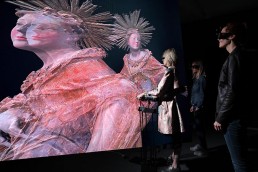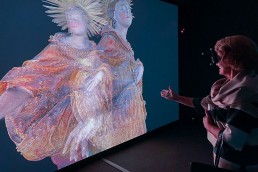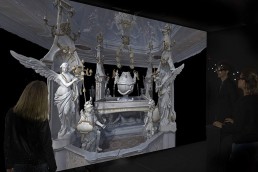This website uses cookies so that we can provide you with the best user experience possible. Cookie information is stored in your browser and performs functions such as recognising you when you return to our website and helping our team to understand which sections of the website you find most interesting and useful.
EPFL Pavilions
ProjectEPFL PavilionsLocationLausanne, SwitzerlandManufacturersDigital Projection and Display Devices - USAArchitectConsensiveInstallerVirtual Reality and Visualization Research group, Weimar Bauhaus UniversitySubmitted byDigital Projection
In addition to the 21 high-tech artworks and virtual experiences on display, visitors to a forward-thinking new exhibition in Switzerland will have front-row seats for another technological first: the combination of Digital Projection’s Satellite MLS system with Multi-View 3D projection technology to help reconstruct Michaelsberg Abbey, a 1,000-year-old Benedictine church in the UNESCO world heritage site of Bamberg, Germany.
Deep Fakes: Art and its Double, which runs until February 2022, is turning heads at EPFL Pavilions in Lausanne with a unique showcase of the emerging digital culture disrupting the art world. From artificial intelligence to computer vision, interactive and immersive media to 3D and 5D printing, technology is revolutionising how art is conceived, created and experienced, and Deep Fakes is the first exhibition to deal with this technological transformation at scale and intensity.
The 1,000m² exhibition is “the culmination of several years of new creative practices emerging from the world of computer science,” explains the exhibition’s curator, EPFL Pavilions director Sarah Kenderdine, who has dubbed these new artefacts, which borrow or build upon existing artworks, ‘cultural deep fakes’. “It was only recently that artists and producers began to fully grasp the potential of computational production and new forms of art,” adds Kenderdine, a professor of museology who has more than 20 years’ experience developing and producing large-scale immersive and interactive exhibitions for museums, as well as world heritage sites throughout Asia such as Angkor in Cambodia and, in Europe, Greece’s Olympia.
Among the ‘cultural deep fakes’ on exhibit at EPFL Pavilions, located on the campus of the Swiss Federal Institute of Technology of Lausanne (EPFL), are The Next Rembrandt, which uses artificial intelligence to create a ‘new’ work from the Dutch master, who lived and died in the 17th century; The Golden Calf, by seminal media artist Jeffrey Shaw, which reveals itself only when the visitor has circled around its pedestal in a “dance of veneration”; and Abbey Saint Michel, Bamberg, a complete digital reconstruction of the interior of the 1,000-year-old monastery.
The physical Michaelsberg Abbey has been closed for renovations since 2012, when structural damage was discovered. As part of the restoration process, 3D laser scanning specialist ArcTron was commissioned by the city of Bamberg to create a high-resolution, photorealistic recreation of the church’s interior, which contains significant works of late-Renaissance and Rococo art, sculpture and architecture.
For the Deep Fakes exhibition, the Virtual Reality and Visualization Research group at Weimar’s Bauhaus University and spin-off company Consensive developed real-time rendering techniques for ArcTron’s 3D models, allowing them to be presented in immersive VR using Multi-View, Digital Projection’s multi-user 3D projection technology.
The Digital Projection system in Lausanne, which was also installed by Bauhaus University, comprises one INSIGHT Satellite MLS 4K HFR 360 projector, along with six pairs of Volfoni-made glasses. Using the ultra-fast frame rates (360fps) unique to Multi-View, this single projector is able to provide a true 3D experience to several viewers, each of whom has a view of the exhibit that remains appropriate to their changing position. This allows the users to see and interact with each other in a truly shared collaborative manner.
“Instead of providing 120 frames per second, which is enough only for single-user 3D, the INSIGHT Satellite MLS 4K HFR 360 delivers an unrivalled 360 frames,” confirms Kenderdine, who says the technology is quite simply revolutionary for heritage experts, in that it can provide everyone viewing a digital artwork with a shared experience. “Giving each user a unique perspective on an object provides us with unpredicted ways to collaborate,” she enthuses.
In Satellite MLS (Modular Laser System) spec, the INSIGHT Satellite MLS 4K HFR 360 offers museum professionals an even more compelling solution for modern multi-media exhibitions, explains Digital Projection’s Thierry Ollivier, who is leading the company’s involvement in the Deep Fakes project. With Satellite MLS, the small, lightweight projector head is dissociated from the light source, which allows for bright, 4K projection with a compact footprint and minimal noise/heat generation near the exhibits themselves. This unique design, says Ollivier, makes Satellite MLS ideal for theatres and opera houses, historic buildings, and other heat/space-restricted applications.
Technologies such as Multi-View and Satellite MLS will play an increasingly important role in future art and museum exhibitions, where AV will help immerse visitors in ever-more interactive experiences, concludes Kenderdine. “At a museum level, these tools offer new ways to tell stories: stories that are not necessarily didactic, stories that are emerging and responding to user interaction, and stories visitors can embody and inhabit. AV opens up the archive and gives it so much more potential for reuse. It gives artists and creators and curators a new canvas to create aesthetic frameworks we have never seen before, and modalities of engagement which transport and delight visitors”
As for the Digital Projection solution specifically, EPFL Pavilions couldn’t be happier, she adds. “The unit worked like a dream – with remote support from Digital Projection it was up and running in half a day.
“The public also adore it. They recognise the difference; it’s like nothing they have seen before. And the scientists at EPFL have also come for multiple visits to the exhibition, to see the new opportunities presented by the technologies.”
“Working with Professor Kenderdine for the last ten years on projects involving projection and virtual reality, I applaud her talent and efforts to bridge the gap between technology and art,” adds Ollivier. “With Deep Fakes, by combining expertise from Digital Projection, Consensive and Volfoni, Sarah and her team have demonstrated to a wide range of audiences, from world-leading cultural authorities to local students, what a virtual reality experience should be like. Seeing is believing.”



